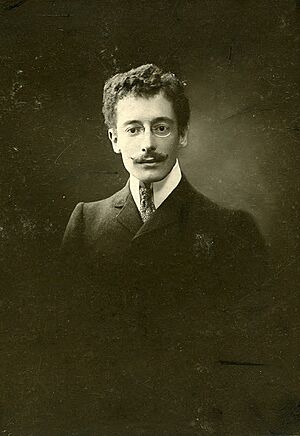Victor Segalen facts for kids


Victor Segalen (born January 14, 1878 – died May 21, 1919) was a French writer, poet, and explorer. He was also a doctor for the navy. Victor Segalen was very interested in different cultures and ancient history. He studied people and their customs (an ethnographer) and also old buildings and artifacts (an archeologist). He wrote about art, studied languages, and reviewed books.
He was born in Brest, France. He studied medicine in Bordeaux to become a navy doctor. He traveled a lot, living in Polynesia from 1903 to 1905 and in China from 1909 to 1914, and again in 1917. Victor Segalen passed away in a forest in Huelgoat, France. He was found with a copy of Hamlet by William Shakespeare next to him.
Contents
What is Victor Segalen Known For?
His Contributions to French Culture
In 1934, the French government honored Victor Segalen by adding his name to the walls of the Panthéon. This was to remember his service to his country during World War I.
Several places are named after him. These include the Victor Segalen Bordeaux 2 University in Bordeaux, which teaches medicine, literature, and social sciences. The Faculty of Arts and Social Sciences in Brest, his hometown, is also named after him. Even the French International School of Hong Kong carries his name.
Victor Segalen's Family Life
Who Was Victor Segalen's Family?
Victor Segalen married Yvonne Hébert on June 2, 1905, in Brest. They had three children together: Yvon (born 1906), Annie (born 1912), and Ronan (born 1913).
Some experts who study Chinese art, including Victor Segalen, use the word "chimera" to describe certain mythical creatures. These are often winged animals that look like lions or a mix of different animals, such as bixie, tianlu, and qilin.
Victor Segalen's Writings and Discoveries
What Books Did Victor Segalen Write?
Victor Segalen wrote many books and essays during his life. He explored different cultures and shared his thoughts through his writing. Some of his famous works include:
- Les Immémoriaux (published under the name Max Anély), 1907. This book is about his experiences in Polynesia.
- Stèles, 1912. This is a collection of poems.
- Peintures, 1916. This book explores art.
- Essai sur l'exotisme (Essay on Exoticism), published after his death in 1978. This work discusses his ideas about different cultures and places.
Books Published After His Death
Many of Victor Segalen's works were published after he passed away. These include:
- Thibet (Tibet), published in parts in 1963 and fully in 1979.
- René Leys, 1922. This is a novel.
- Mission archéologique en Chine (Archaeological Mission in China), 1923–1924. He worked on this with Gilbert de Voisins and Jean Lartigue.
- Équipée. De Pékin aux marches tibétaines… (Journey. From Beijing to the Tibetan Borders…), 1929. This book describes his travels.
- La Grande Statuaire chinoise (The Great Chinese Statuary), 1972. This book is about large Chinese sculptures.
His Work in Archaeology
Victor Segalen also led important archaeological missions. He helped explore and document ancient sites, especially in China. His reports include:
- Rapport de la Mission archéologique Victor Segalen (Report of the Victor Segalen Archaeological Mission), 1917.
- Le tombeau du fils du roi de Wou – Ve siècle avant notre ère (The Tomb of the Son of the King of Wu – 5th Century BCE), 1922.
- Rapport de la Mission archéologique en Lartigue, Segalen et de Voisins (Report of the Archaeological Mission by Lartigue, Segalen, and de Voisins), 1923–1924.
Learning More About Victor Segalen
Books Written About Victor Segalen
Many authors have written books to help us understand Victor Segalen's life and work better. Some of these include:
- Victor Segalen by Henry Bouillier (1961).
- Segalen by Gilles Manceron.
- Victor Segalen and the Aesthetics of Diversity by Charles Forsdick (2000).
- "Making New Classics: The Archaeology of Luo Zhenyu and Victor Segalen" by Wang Tao and Denis Thouard (2013).
See also
 In Spanish: Victor Segalen para niños
In Spanish: Victor Segalen para niños


